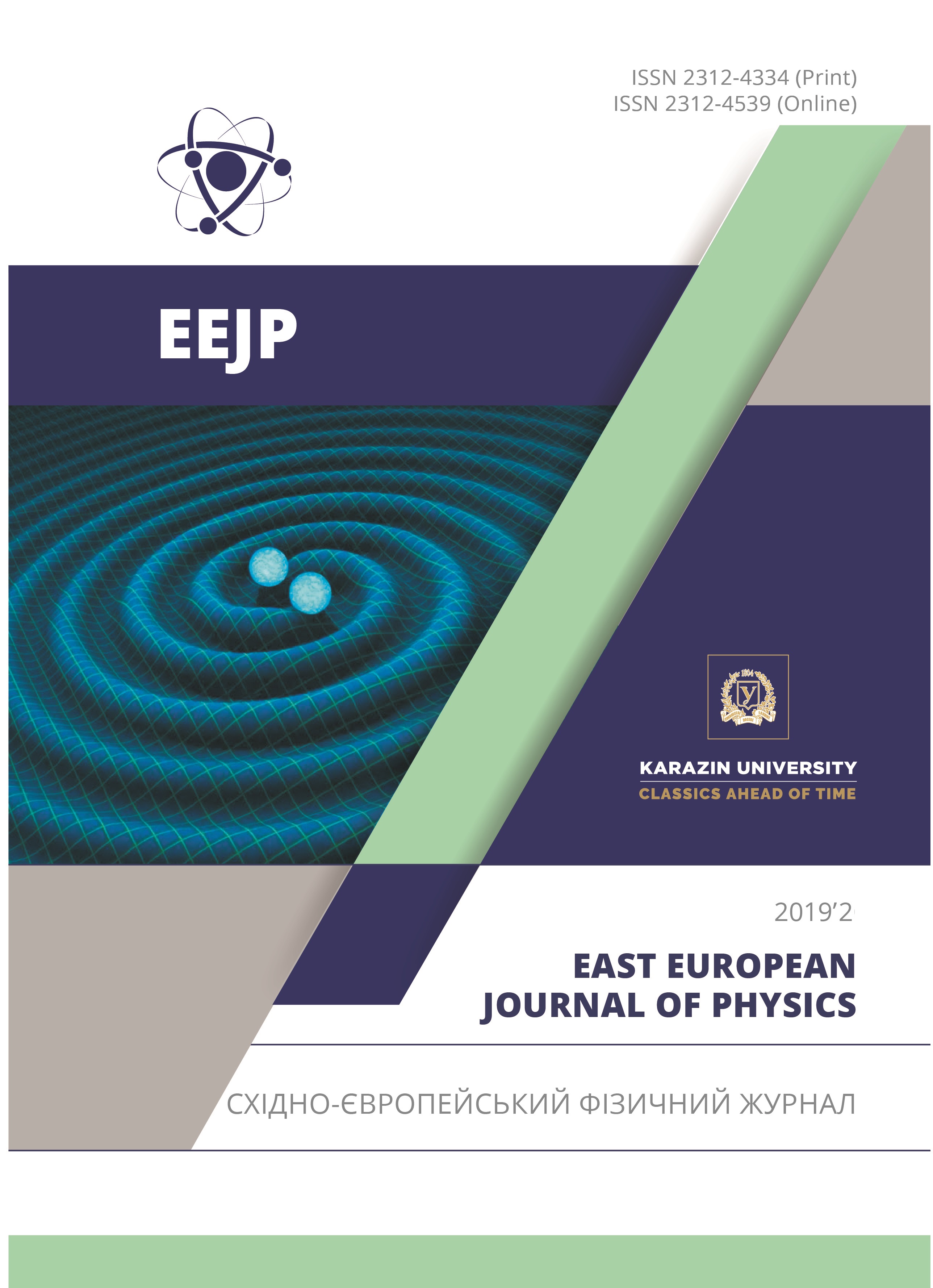Research of the Single Crystal and Multilayer Composite Detectors Response Under Irradiation by Fast Neutrons
Abstract
The object of this work was to study the response of the detectors based on the oxide scintillators under irradiation by a flux of fast neutrons from 239Pu-Be source by counting photomultiplier tube pulses. In the process of the research the counting efficiency of the detectors was measured in units of (pulse×s-1×cm-2)/(neutron×s-1×cm-2) for single-crystal and multilayer composite detectors ZWO (ZnWO4), CWO (CdWO4), BGO (Bi4Ge3O12, composite). The measured response for ZWO detector was ~ 64 pulse/neutron, for CWO ~ 36 pulse/neutron, for BGO ~ 0.44 pulse/neutron. The detectors response was registered by a fast preamplifier with the operation speed of up to 500 MHz, based on high-speed operational amplifiers with voltage feedback. The statistical error of measurement for the neutron registration efficiency by the broadband channel made 7% for the detectors with the effective thickness of ~ 40-50 mm, which is due to the spherical geometry of the experiment. The formation of the detector response is affected by the following parameters of neutron reactions: cross section of inelastic and resonant scattering of scintillator nuclei, density of composite nuclei levels, resonance region width, lifetimes of long-lived states and their number. The measured values of the counting efficiency of fast neutrons registration are accounted for the fact that the inelastic scattering reaction for some nuclei is the starting point that triggers the cascade process of the nuclear states discharge. The registration of the cascade of the discharge gamma-quanta, ranging from nanoseconds to a few microseconds, causes an increase in the detector counting efficiency and, as a consequence, an increase in the detector sensitivity to neutron detection. The observed increase in the counting efficiency of secondary gamma quanta is realized when the neutrons are slowed down in the detectors having sufficiently noticeable thickness and appropriate isotopic composition.
Downloads
References
M. Anelli, G. Battistoni, S. Bertolucci, C. Bini, P. Branchini, C. Curceanu, G. De Zorzi, A. Di Domenico, B. Di Micco, A. Ferrari, P. Gauzzi, S. Giovannella, F. Happacher, M. Iliescu, M. Martini, S. Miscetti, F. Nguyen, A. Passeri, A. Prokofiev, P. Sala, B. Sciascia and F. Sirghi, Nuclear Instruments and Methods in Physics Research A, 581, 368-372 (2007), https://doi.org/10.1016/j.nima.2007.08.005.
L.L. Nagornaya, V.D. Ryzhikov, B.V. Grinyov, L.A. Piven’, G.M. Onyshchenko and E.K. Lysetska, Abstracts IEEE Nuclear Science Symposium, (Drezden, Germany, 2008).
B. Grynyov, V. Ryzhikov, L. Nagornaya, G. Onishcenko and L. Piven’, Patent of USA. US 8.058.624 B2 (15 November 2011).
V.D. Ryzhikov, B.V. Grinyov, G.M. Onyshchenko, L.A. Piven, O.K. Lysetska, O.D. Opolonin, S.A. Kostioukevitch, and C.F. Smith; Proceedings Volume 9213, Hard X-Ray, Gamma-Ray, and Neutron Detector Physics XVI, 92131B (San Diego, California, 2014), https://doi.org/10.1117/12.2058185.
V.D. Ryzhikov, S.V. Naydenov, G.M. Onyshchenko, L.A. Piven, T. Pochet and C.F. Smith, Nuclear Instruments and Methods in Physics Research Section A: Accelerators, Spectrometers, Detectors and Associated Equipment, 903, 287-296 (2018), https://doi.org/10.1016/j.nima.2018.06.074.
I. Yakymenko, B. Grinyov, V. Ryzhikov, G. Onyshchenko, S. Naydenov, O. Opolonin and S. Makhota, Sixth International Conference “Engineering of scintillation materials and radiation technologies ISMART”, (Minsk, 2018), pp. 46.
V.D. Ryzhikov, G.M. Onishenko, I.I. Yakimenko, S.V. Najdenov, A.D. Opolonin and S.V. Mahota, XVII конференция по физике высоких энергий и ядерной физике [XVII Conference on High Energy Physics and Nuclear Physics], (NSC “KIPT”, Kharkiv, 2019), pp. 96.
J.M. Blatt and V.F. Weisskopf, Theoretical Nuclear Physics, (2010).
A.I. Abramov, Ju.A. Kazanskij and E.S. Matusevich, Основы экспериментальных методов ядерной физики [Fundamentals of experimental methods in nuclear physics], (Energoatomizdat, Moscow, 1985), pp. 488.
G. Venkataraman, Dayashankar and J.S. Jayakar, Nuclear Instruments and Methods, 82, 49-50, (1970), https://doi.org/10.1016/0029-554X(70)90323-X.
T. Egidy and D. Bucurescu, Physical Review C, 72, 044311 (2005), https://doi.org/10.1103/PhysRevC.72.044311.
V.D. Ryzhikov, S.V. Naydenov, T. Pochet, G.M. Onyshchenko, L.A. Piven and C.F. Smith, IEEE Trans. Nuclear Sciences, 65(9), 2547-2553 (2018), https://doi.org/10.1109/TNS.2018.2825642.
V.D. Rizhikov, V.O. Litichevskij, G.M. Onishchenko, L.O. Piven et al, Patent UA 109524 С2, (25 August 2015), (in Ukrainian).
V.D. Ryzhikov, S.V. Naydenov, T. Pochet, G.M. Onyshchenko, L.A. Piven and C.F. Smith, EPJ Web of Conferences, 170(5), 07010 (2018), https://doi.org/10.1051/epjconf/201817007010.
Citations
The Threshold of Detection of Fission Materials by ZnWO4 and Bi4Ge3O12 Scintillation Detectors
(2019) East European Journal of Physics
Crossref
Copyright (c) 2019 Volodymyr Ryzhikov, Gennadiy Onyshchenko, Ivan Yakymenko, Sergei Naydenov, Alexandr Opolonin, Sergei Makhota

This work is licensed under a Creative Commons Attribution 4.0 International License.
Authors who publish with this journal agree to the following terms:
- Authors retain copyright and grant the journal right of first publication with the work simultaneously licensed under a Creative Commons Attribution License that allows others to share the work with an acknowledgment of the work's authorship and initial publication in this journal.
- Authors are able to enter into separate, additional contractual arrangements for the non-exclusive distribution of the journal's published version of the work (e.g., post it to an institutional repository or publish it in a book), with an acknowledgment of its initial publication in this journal.
- Authors are permitted and encouraged to post their work online (e.g., in institutional repositories or on their website) prior to and during the submission process, as it can lead to productive exchanges, as well as earlier and greater citation of published work (See The Effect of Open Access).








